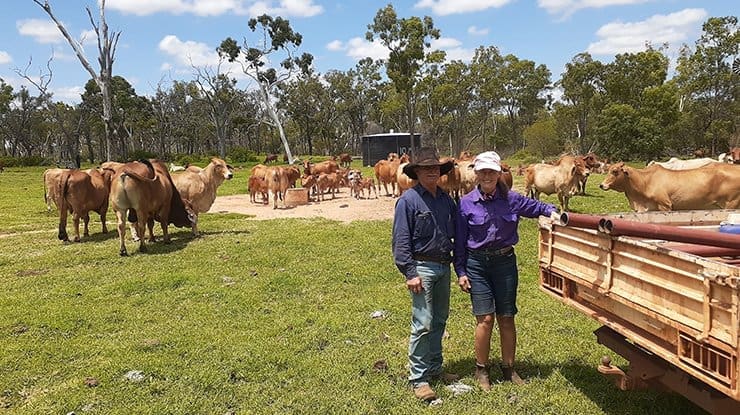
Peter and Anne Finlay say that to get the most out of their Red Brahmans breeders, P is essential
North Queensland beef producers Peter and Anne Finlay know that to get the most out of their country they can’t ignore the importance of phosphorous supplementation, so they take a year‑round approach to providing this important trace mineral for their cattle.
It’s been their focus for the past 25 years as they knew their soil was phosphorous (P) deficient when they purchased their property Julia Park at Torrens Creek.
Deficient soils in many northern production systems can lead to insufficient P in the pasture to meet animals’ requirements for vital functions such as building bones and teeth, and producing milk.
The Finlays feed cattle P year‑round, adjusting the level of supplementation to suit the season and breeding requirements.
During the wet season, while there is green feed about, cattle have access to a 50/50 mix of Kynophos – which is 21pc P – and salt lick, fed in tyre troughs.
Breeder intakes during this time are around 46g/head a day, equating to about 10g of P/head a day to match breeder requirements.
“This costs us roughly 30¢/ head a week,” Mr Finlay said.
As it starts to dry off, a 27pc urea lick loose mix is put out, that also contains 12.5pc Kynophos, even before it’s needed, to make sure the cattle have it in their system.
“Cattle intakes of the dry season lick increase to around 200g/head a day, which costs us around $1.12/head a week,” Mr Finlay said.
The Finlays leave the mixture of P and salt out during the dry so cattle can self‑regulate intake of either lick as required.
“As we control-mate, we have very few wet cows during the dry spring period, so I’ve always felt that the 12.5pc Kynophos they are getting with the urea lick is adequate,” he said.
Fertility and weight
The Finlays attribute the P program to strong calving and weaning weights on the property, with a five‑year average of 72pc branding and 69pc weaning rates.
“Considering four of the past five years have been very poor seasons with reduced feed quality, I’m quite happy with those rates,” Mr Finlay said.
“On this country, if you aren’t feeding P, weaning rates can be as low as 50pc, you’ll struggle to produce enough heifers as replacements and growth rates will be back to blazes, so it’s crucial to keep it up.”
On top of strong fertility, the Finlays said P also helps with weight gain, allowing them to turn-off their steers at 26–28 months at between 380–400kg, even in lighter seasons.
Part of the puzzle
The couple have used programs such as MLA’s NutritionEDGE to guide herd nutrition strategies, with P being just one part of their total management approach.
“We’re constantly looking at tweaks we can make, such as cross‑breeding for better fertility and weightgain, rotational grazing strategies and pasture improvement,” Mr Finlay said.
Source: MLA



Pete and Ann .Very good story but no less than I expected . A great example for the feeding of P in low P country and a great example for the wider industry . Greg Brown